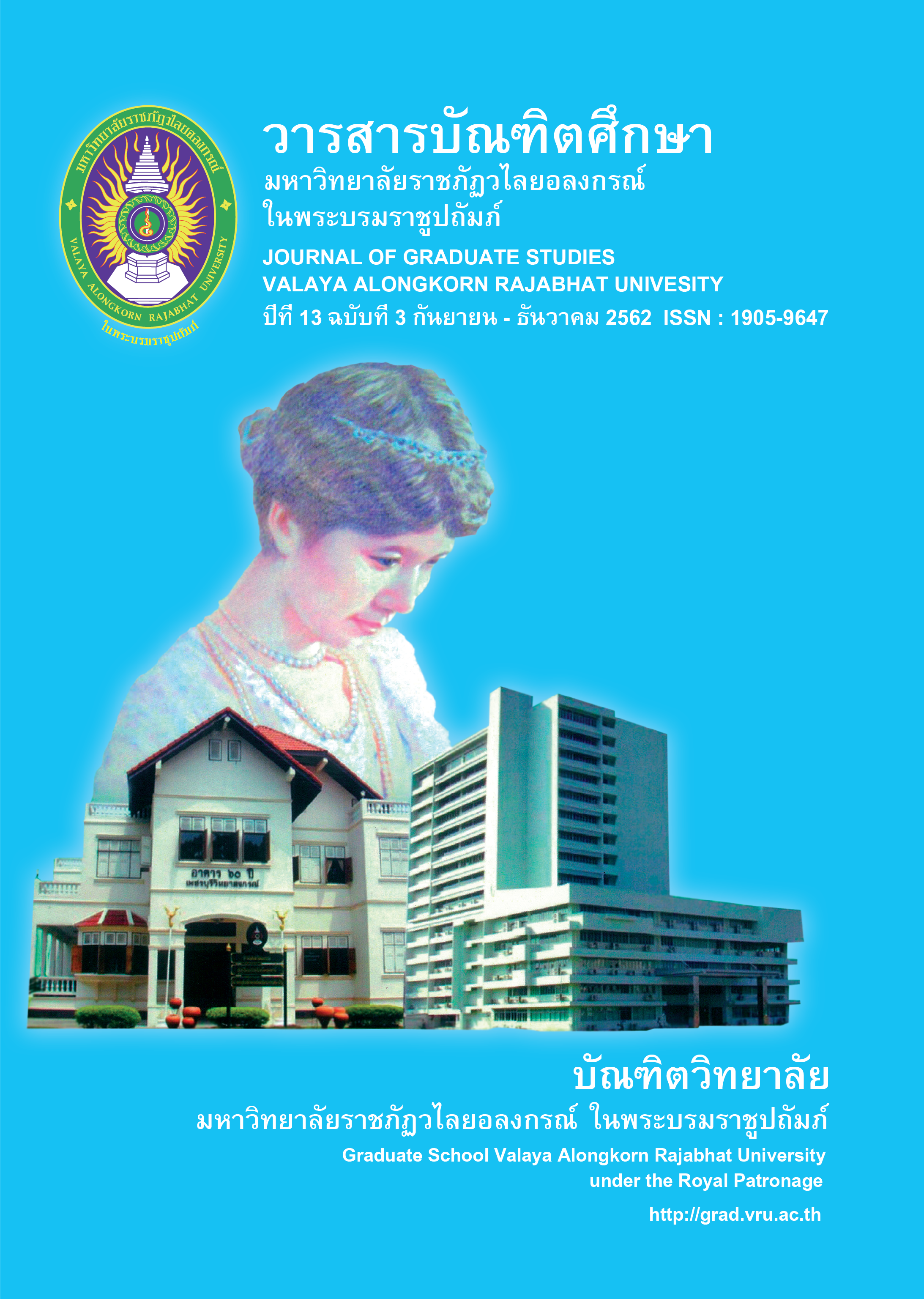THE DEVELOPMENT OF AN ENGLISH INSTRUCTIONAL MODEL TO ENHANCE STUDENT ENGAGEMENT AND ENGLISH READING AND WRITING ABILITIES OF UNDERGRADUATE STUDENTS
Main Article Content
Abstract
The main purposes of this research were 1) to develop an English instructional model to enhance student engagement and English reading and writing abilities of undergraduate students, and 2) to study the effectiveness of the developed instructional model. The sample used in the study was 43 bachelor degree Dhurakij Pundit University students enrolling in the LA102 English2 course in the 2/2017 academic year, randomly obtained by cluster sampling. The instruments used were an assessment form for the student engagement, the English reading and writing ability test and the student satisfaction questionnaire. The reliability of the instruments are 0.85, 0.97 and 0.93 respectively. Data were analyzed by using the mean, standard deviation, paired samples t-test, and content analysis.
The results were as follows:
1) The English instructional model to enhance student engagement and English reading and writing abilities of undergraduate students which is developed by blending the active learning, collaborative learning and motivation comprised of 4 components: (1) principles; (2) objectives; (3) 5 stages of instructional procedures including encouraging, working collaboratively, sharing knowledge creatively, applying knowledge, concluding and reflecting; and (4) assessment and evaluation. The quality of the instructional model had an average of 4.71 which was at the very high level.
2) The effectiveness of the developed instructional model revealed that: 2.1) the developed instructional model could make the student engagement after the instruction higher than before the instruction with the statistical significance at the level of 0.05; 2.2) the student’s the reading and writing ability after the instruction was higher than before the instruction with the statistical significance at the level of 0.05; 2.3) the student’s satisfaction towards the developed instructional model was at the high level in all areas.
Article Details
บทความทุกเรื่องได้รับการตรวจความถูกต้องทางวิชาการโดยผู้ทรงคุณวุฒิ ทรรศนะและข้อคิดเห็นในบทความวารสารบัณฑิตศึกษา มหาวิทยาลัยราชภัฏวไลยอลงกรณ์ ในพระบรมราชูปถัมภ์ มิใช่เป็นทรรศนะและความคิดของผู้จัดทำจึงมิใช่ความรับผิดชอบของบัณฑิตวิทยาลัย มหาวิทยาลัยราชภัฏวไลยอลงกรณ์ ในพระบรมราชูปถัมภ์ กองบรรณาธิการไม่สงวนสิทธิ์การคัดลอก แต่ให้อ้างอิงแหล่งที่มา
References
Borton Capina, A., & Bryan, G. (2017). Engaging reluctant learners in a French Immersion classroom. Current Issues in Education, 20(1).
Carini, R. M., Kuh, G. D., & Klein, S. P. (2006). Student Engagement and Student Learning: Testing the Linkages. Research in Higher Education, 47(1).
Fredricks, J.A., et al. (2011). Measuring student engagement in upper elementary through high school: A description of 21 instruments. National Center for Education Evaluation and Regional Assistance. Institute of Education Sciences.
Jareonsettasin, T. (2018, September 28). britit khaonasin læ krasūang sưksāthikān phlik chōm kānsō̜n khrū phāsā ʻAngkrit 17,000 khon plīan kānsō̜n nēn thō̜ngčham kǣ rom mā - wō khǣp sū kānsư̄sān phāsā ʻAngkrit dai čhing [British Council upskills 17,000 Thai teachers in ‘bootcamp’ project with Ministry of Education]. Retrieved from https://www.ryt9.com/s/prg/2893466
Joyce, B., Weil, M., & Calhoun, E. (2011). Models of teaching (9th ed.). Boston, MA: Pearson Education Inc.
Khaemmanee, T. (2007). sāt kānsō̜n: ʻongkhwāmrū phư̄a kānčhat krabūankān rīanrū thī mī prasitthiphāp [Instructional Sciences: Body of knowledge for organizing effective learning process]. Bangkok: Chulalongkorn University Press.
Klincumhom, T. (2013). mōdēn chœ̄ng sāhēt khō̜ng khwām yưtman phūkphan khō̜ng nakrīan læ phon samrit thāngkān rīan thī kœ̄t čhāk ʻitthiphon khō̜ng khrū [A causal model of student engagement and academic achievement by teacher’s effects]. Master’s thesis. Chulalongkorn University.
Office of the Minister Newsline. (2018, November 26). nayōbāi læ čhut nēn kānčhatkān sưksā khō̜ng krasūang sưksāthikān (Pīngoppramān Phō̜.Sō̜. 2562) [Ministry of Education’s policy and focus on educational management (fiscal year 2019)]. Retrieved from http://www.moe.go.th/websm/2018/5/449.html
Ranabut, S. (2015). kānsưksā læ phatthanā khwām mungman nai kān rīan khō̜ng naksưksā radap parinyā trī sākhā kānsưksā pathommawai [The Study and Development of the Student Engagement of Bachelor Degree Students in Early Childhood Education Program]. Doctoral dissertation. Srinakharinwirot University
Reyes, M. R., et al. (2012). Classroom emotional climate, student engagement, and academic achievement. Journal of Educational Psychology, 104(3): 700-712.
Termsinsawadi, P. (2009). kānphatthanā botrīan wepkhawēt phư̄a sœ̄msāng khwāmsāmāt nai kān ʻān læ kān khīan phāsā ʻAngkrit læ kānmī sūanrūam nai kān rīan khō̜ng naksưksā radap parinyā trī sākhā witsawakammasāt mahāwitthayālai theknōlōyī rāt mongkhon phra nakhō̜n witthayākhēt phra nakhō̜n nư̄a [A development of webquest modules to enhance English reading and writing abilities and learning engagement of undergraduate engineering students at Rajamangala University of Technology Phra Nakhon, North Bangkok Campus]. Doctoral dissertation. Chulalongkorn University.


